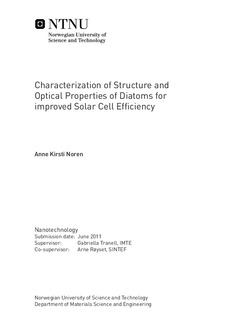Characterization of Structure and Optical Properties of Diatoms for improved Solar Cell Efficiency
Master thesis
Permanent lenke
http://hdl.handle.net/11250/248947Utgivelsesdato
2011Metadata
Vis full innførselSamlinger
Sammendrag
Interest in renewable energy resources has increased in recent years, and solar cells are one of the areas that have been subject to intensive research. For solar energy to develop into a competitive alternative to fossil fuels, the ratio between cost and efficiency has to be reduced. One of the reasons for low efficiency is the optical losses due to reflection and poor absorption of the red and infrared segment of the light spectrum. Applying more ideal anti-reflection structures and a back-side diffraction layer to increase the path length of light would certainly constitute steps in the right direction. Diatoms, a type of algae, are one of nature's most efficient light harvesting structures. It is suggested that their nano- and microporous silica shell (frustule) possess optical properties that make them attractive options for increasing the efficiency of solar cells. This project aimed at studying the structural and optical properties of selected diatom species and investigating the potential for efficiency enhancements in solar cells through the incorporation of diatoms. Two different species,emph{Coscinodiscus wailesii} and emph{Coscinodiscus sp.}, were investigated through the use of a scanning electron microscope. They were found to have different structures, with the frustule of emph{Coscinodiscus sp.} as having a more regular pore pattern and a more complex structure consisting of several silica layers. The emph{Coscinodiscus sp.} structure was chosen as the foundation for modelling a diffraction grating in GD-Calc, a Matlab implemented simulation software based on rigorous coupled-wave analysis. The diffraction simulations were carried out both on the grating in air and on the grating incorporated in solar cell-like setups. The simulations demonstrated that the diatom structure diffracted light efficiently to higher orders. It was also shown that the anti-reflection structure provided low levels of reflection for a given set of geometric combinations. The back-side diffraction grating reflected light with efficiencies of 0.9, however, the level of diffraction to higher orders was below 0.1. This study shows that that diatom frustule exhibits interesting diffraction grating properties which should be investigated further, both for solar cell schemes and for other applications.
